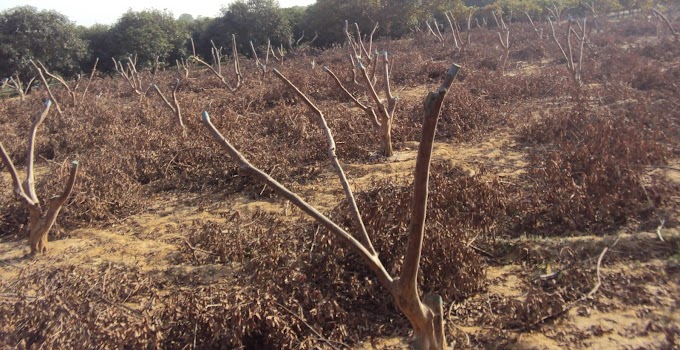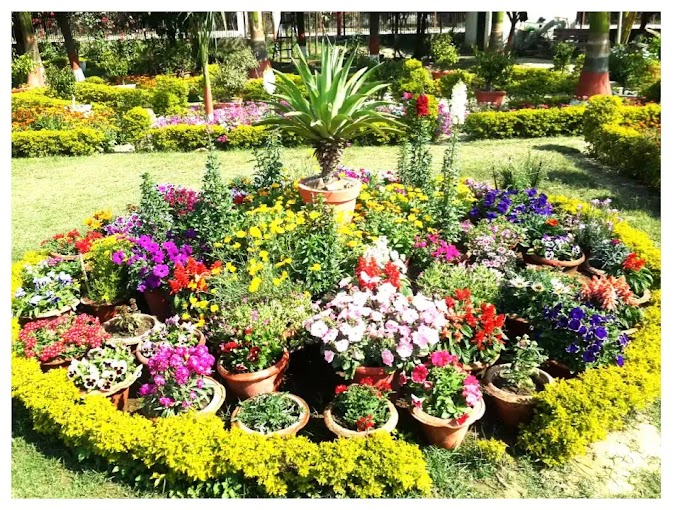Wind is useful for
orchard if it blows at normal velocity but too hot or cold wind of high
velocity is always harmful to the orchards.
Good
effects of Wind: The followings are the advantages of
the normal wind:
1. The
wind blows away Co2 and ethylene gases from the interiors of the
orchard and fills with fresh air which results good metabolic activities of
orchard plants.
2. The
wind lowers the relative humidity inside the orchards. The high relative
humidity may cause dew and diseases in the orchards.
Harmful
effects of wind: The wind of high
velocity, storm, cyclones, cold and hot
wind (Loo) causes damage to orchards in
the following ways:
1. The
high wind velocity uproots trees and blows down their branches.
2. The
leaves, flowers and fruits fall due to storm and cyclones.
3. The
hot wind causes higher rate of evapo-transpiration and thereby loss of soil
moisture.
4. The
hot air causes cracking and shriveling of fruits in many species.
5. The
high wind causes undesirable stress in fruit plants by tilting trees
and their branches.
6. The
high wind velocity tears the leaves of fruit trees such as in banana and
papaya.
7. The
high wind causes soil erosion and thereby blows away fertile surface soil of
the orchards.
8. It
deprives the orchard soil from organic matters by blowing away fallen leaves
and twigs from the orchards.
9. The
too cold wind causes low temperature injury to tropical and subtropical fruit
trees.
10. The
wind of high velocity blows away pollen grains and pollinating insects, thus
interfering in the pollination and fruit setting.
What
is wind-break?
The wind-break is a
barrier of trees rows which reduces the wind velocity. The wind break may
include tall trees, shrubs, bushes and grasses. The one or more rows of wind-break
are planted at right angle to the direction of the wind. The single row wind
breaks are common in practice however the wind break consisting more than one
rows are more effective. When planting more than one rows wind break the row of
smaller plants should be planted at wind ward side (outer side) of the orchard
then intermediate row of middle height plants and finally the third row of
taller plants at leeward side (inner most side) of the orchard. The spacing
should be close to get the compactness in the wind break. In Northern India hot wind of high velocity
blows from west therefore, wind break rows of plants are planted at western boundary
of the orchards. The plant species selected for wind break rows must be according
to agro-climatic conditions of the location and capable to withstand with hot
wind of high velocity. The trees are planted for wind break rows even inside of
the orchard at specific distance if orchard is large.
Precautions
in planting of wind break
A trench of 1m depth may
be dug between outer most (wind ward side) row of fruit trees and inner most
(leeward side) row of wind break trees to avoid the competition between roots
of fruit trees and wind break trees for nutrients and water. The trench should
be about 1 meter deep and 3 meters away from leeward side row of wind break
trees. The all the roots of wind break trees exposed in the trench should be
cut off regularly.
Suitable
species for wind break
The plant species including trees, shrubs and
grasses should have capacity to withstand with high wind velocity without
falling, tilting and breaking. The trees should also be resistant to pests and
diseases and should not host pests and diseases causing damage to fruit trees.
The species bearing edible fruits and otherwise suitable may be preferred as
these species producing fruits thus adding to income of the orchard. These
plant species may be planted as wind-break rows: Seedling mango (Mangifera indica), Jamun (Syzyziun cuminii), Jack fruit (Artocarpus heterophyllus), Khirni (Manilkhara hexandra), Karonda (Carissa carandas), Ber (Ziziphus jujube), Jangal Jalebi (Inga dulcis), Mulberry (Morus nigra), Neem (Azadirachta indica), Arjun (Terminalia
arjuna), Cassia siamia, Babool (Acacia arabica), Shisham (Dalbergia sissoo), Sarpat (Saccharum munja), Imli (Tamarindus indica) and Mahuna (Madhuca latifolia).
Advantages
of wind break
1. It
reduces the wind velocity and prevents damage caused by high velocity of wind.
2. It
decreases the evaporation losses of water from the soil surface.
3. It
also prevents the damage caused by cold wind and frost.
4. It
increases the fruit production and quality by minimizing wind damage.
5. It
reduces the cost of cultivation by controlling the damage.
Disadvantages
of wind break
1. It
occupies some land of the orchard otherwise fruit trees would have planted on
the land.
2. It
competes with fruit trees for nutrients and water.
3. It
may cause shade effect on the orchard.
4. It
provides shelter to birds and harbor insects and diseases which may cause
damage to the orchard.
5. It
needs additional cost, care and maintenance.







